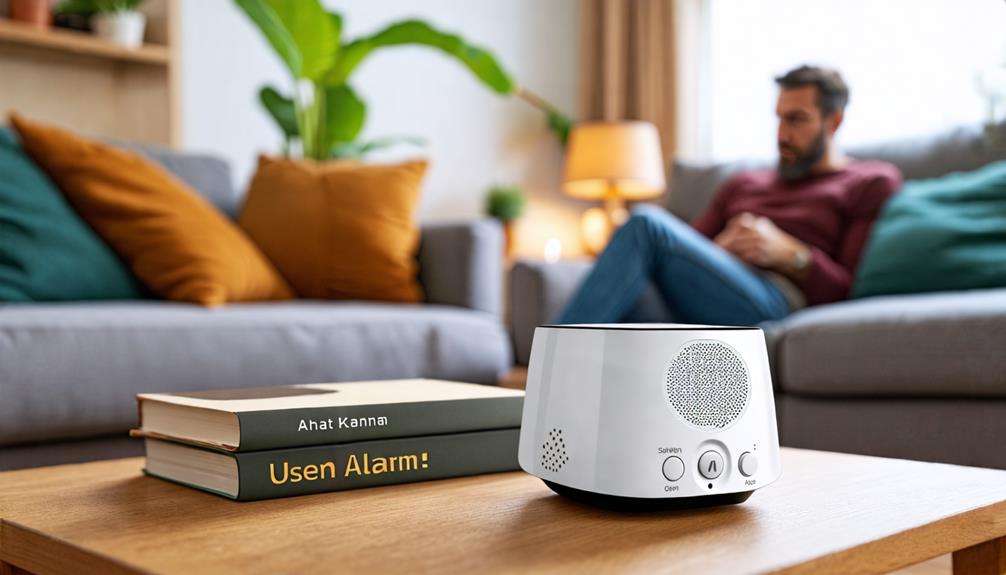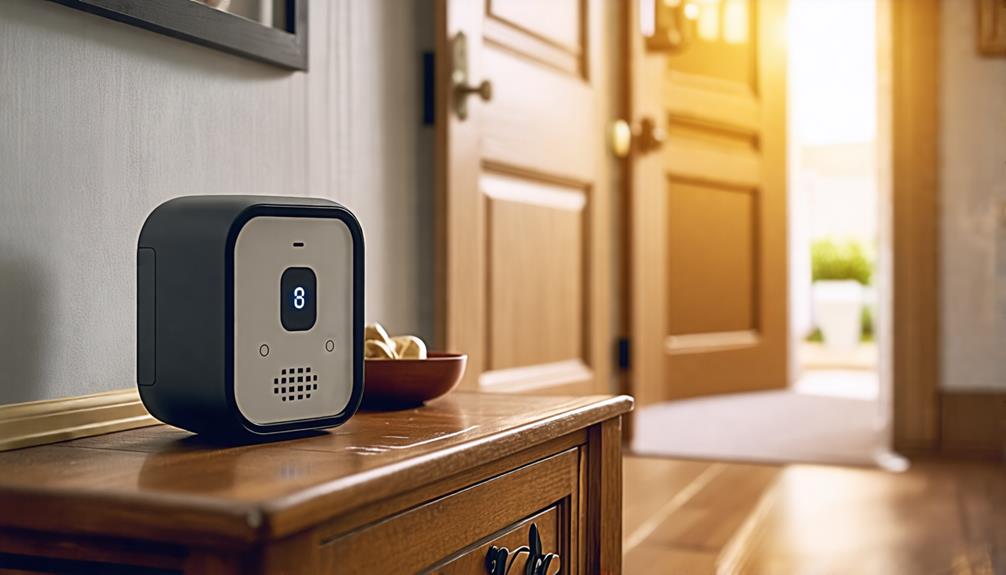
Brainstorm Security Shop

For Orders Over $199

On Any Of Our Products

Details On Refund Page
Have you ever considered enhancing your home security with a Barking Dog Alarm with Remote? This clever device mimics the sound of a protective dog, deterring potential intruders without the need for an actual pet. You can adjust the sensitivity and volume to suit your environment and manage it effortlessly from a distance with its handy remote. But beyond the basic features, how does it integrate with your existing smart home system? And what are the hidden benefits and potential drawbacks you should be aware of? Let’s explore how this innovative tool can fit into your overall security strategy.
While barking dog alarms might sound unusual, they’re highly effective security devices. You might wonder how they work and why they’re considered a smart choice for protecting your home. Essentially, these alarms use sensors with high sound sensitivity to detect movement or intruders. Once triggered, they emit a recording of aggressive barking behavior, which realistically mimics a real dog.
The brilliance behind these alarms lies in their simplicity and the psychological edge they provide. Intruders are often deterred by the sound of barking, associating it with the presence of a potentially dangerous dog.
Moreover, the sound sensitivity of these devices is finely tuned to differentiate between everyday disturbances and potential threats, reducing false alarms and ensuring reliability.
You’ll find that using a barking dog alarm means you don’t have to deal with the responsibilities of owning a real dog while still benefiting from the protective illusion one provides. It’s a hassle-free, low-maintenance solution that keeps your home safe.

Typically, barking dog alarms come packed with a variety of features designed to enhance your home security efficiently.
You’ll find that these innovative devices aren’t just about loud noises; they’re smart, adaptable, and incredibly user-friendly. One of the core aspects you’ll appreciate is the alarm sensitivity settings. These allow you to adjust how responsive the alarm is to various stimuli, ensuring that it reacts appropriately to genuine threats without being set off by minor disturbances.
Another crucial feature is the remote control functionality. This lets you activate or deactivate the alarm from a distance, providing convenience and control wherever you might be in your home. Plus, you won’t have to worry about getting up to reset the system manually.
Here are some additional specifications to consider:
These features make the barking dog alarm a versatile and essential tool for maintaining security at your residence.
Building on the convenience offered by features like remote control functionality in barking dog alarms, the benefits of remote-controlled security systems extend far beyond simple ease of use.
You’ll find that the remote convenience provided allows you to activate or deactivate your security system from anywhere. Whether you’re in your backyard or halfway around the world, managing your home’s security is at your fingertips. This flexibility means you’re always in control, able to respond swiftly to any alerts without needing to physically be there.
Moreover, the security assurance that comes with these systems can’t be overstated. With real-time notifications sent directly to your smartphone, you’re the first to know if something’s amiss. This kind of instant alert mechanism enhances your ability to keep a vigilant eye on your property, ensuring peace of mind.
It’s not just about deterring potential intruders; it’s about creating a responsive environment that addresses security concerns before they escalate.
Remote-controlled systems also integrate seamlessly with other smart home devices, offering you a comprehensive approach to home security.
You’ll appreciate how these sophisticated systems contribute to a safer, more connected living space.
Installing your barking dog alarm is straightforward and doesn’t require professional help. First, decide if you want to go with traditional wiring techniques or opt for modern wireless options. Wireless systems are typically easier to set up and offer more flexibility in terms of placement without dealing with cables.
Here are a few steps to ensure a smooth installation:
Once you’ve installed your barking dog alarm, it’s important to optimize its placement to ensure maximum effectiveness. The key to achieving this is understanding the unit’s sound sensitivity and its outdoor durability. You’ll want to place the alarm where it can best detect intruders without being triggered by unnecessary noise.
Firstly, consider the areas that are most vulnerable to break-ins, such as near doors or ground-level windows. Position the alarm so that its sensors can effectively cover these zones without any obstructions. Make sure it’s set up at a height where it won’t easily be tampered with by an intruder, yet low enough to accurately detect the specific sound frequencies of human activity.
For homes with yards, take advantage of the alarm’s outdoor durability. Place it near the entrance of your backyard or garden. This not only enhances security but also utilizes the alarm’s full potential in outdoor conditions, ensuring it remains effective regardless of weather changes.
Lastly, test different placements to find the optimal spot where the alarm performs best. Adjust the sensitivity settings accordingly to minimize false alarms while maintaining a high level of security.
You’ll find that a bit of tweaking can go a long way in maximizing the effectiveness of your barking dog alarm.

To keep your barking dog alarm functioning optimally, it’s crucial to establish a regular cleaning routine.
You’ll also need to set a schedule for replacing the batteries to ensure it doesn’t fail when you need it most.
These simple steps can greatly extend the life and effectiveness of your device.
Maintaining your barking dog alarm involves a regular cleaning routine to ensure its optimal performance. Keeping it clean not only extends the lifespan of the device but also maintains its sensitivity and effectiveness.
You’ll want to establish a cleaning frequency that matches your home environment. If you’re in a dusty area or have pets, you might need to clean it more often. Generally, a monthly cleaning is advisable to keep everything in top shape.
When it comes to cleaning tools, use soft, non-abrasive cloths to wipe down the exterior. Avoid harsh chemicals or water, which could damage the internal components.
Here are a few key points to remember:
After ensuring your barking dog alarm is clean, don’t forget to check and replace its batteries regularly to keep it functioning properly. Knowing when to change the batteries and understanding the different battery types can save you from unexpected malfunctions.
Most barking dog alarms use either AA or AAA batteries, but some models might require specialty batteries. Always refer to your user manual for the specific battery type your device needs. It’s essential to use the recommended battery type to ensure optimal performance and avoid any damage to the alarm system.
Replacement indicators are crucial for maintaining your alarm’s effectiveness. Some common signs that it’s time to replace the batteries include a decrease in sound volume, less frequent activation, or no response at all.

If your alarm features a low battery indicator, usually a light or a beep, don’t ignore it. This feature is designed to give you ample time to replace the batteries before they die completely.
To avoid being caught off-guard, set a regular schedule for checking the batteries. Every three to six months is a good rule of thumb, but this can vary based on how often the alarm is triggered.
Mark your calendar or set a reminder on your phone to help you remember this important task.
When choosing a barking dog alarm, comparing the top market models is essential to find the best fit for your security needs. You want a device that not only sounds realistic but also integrates seamlessly with your home security setup.
Delve into product reviews and consider user experiences to gauge reliability and effectiveness.
Here’s what you should look at:
Now that you’re familiar with the top barking dog alarms, it’s crucial to optimize their placement and understand how to respond effectively during an incident.
You’ll want to position your alarms where they can best detect intruders yet remain out of obvious sight. This approach not only enhances the effectiveness of your security system but also ensures you’re prepared to act swiftly if the alarm is triggered.
To maximize the effectiveness of your barking dog alarm, it’s crucial to consider its placement carefully. Where you put the alarm can significantly impact its barking frequency and deterrent effectiveness. You want intruders to believe there’s a real dog on your property, ready to protect it at any moment.
Here are a few strategic placement tips to help you enhance your home’s security:
Effective response protocols are essential in enhancing your home safety strategies. When your barking dog alarm triggers, the speed and efficiency of your response can significantly influence the outcome. You’ve got to know what to do when that alarm blares to ensure your home remains a fortress.
Firstly, adjust the alarm’s sensitivity to minimize false triggers while ensuring it’s responsive enough to real threats. You don’t want to be running to the door for every stray cat that wanders by, right? On the other hand, you need it sensitive enough to alert you at the first sign of trouble.
Here’s a simple guide to help you set up:
| Action Item | Description |
|---|---|
| Check Alarm Status | Regularly test alarm sensitivity and battery to ensure optimal functionality. |
| Immediate Check | Verify the cause of the alarm activation through a security camera or peephole. |
| Inform Authorities | If a threat is confirmed, call local law enforcement with minimal delay. |
| Review and Adjust | Post-incident, analyze response time and adjust protocols as needed. |

You might wonder if your system can tell the difference between people and pets moving around.
Unfortunately, it doesn’t specifically distinguish between human and animal movements.
However, it does feature adjustable motion detection sensitivity.
This means you can tweak the settings to reduce false alarms triggered by your pets.
Adjusting the pet sensitivity effectively helps minimize unnecessary alerts, making the alarm system more tailored to your specific household needs.
Yes, the alarm sound is adjustable in both volume and tone, enhancing your user experience.
You can tailor the sound quality to fit your environment, whether you need it louder for deterrence or softer to avoid disturbing neighbors.
This flexibility ensures you’re in control of the auditory settings, making it ideal for various situations.
Adjustments can typically be made easily via a remote control, providing convenience and efficiency in managing the settings.
Yes, you can choose from various alternative alarm sounds besides barking.
These options help you customize the sound to match your security needs or preferences, enhancing the alarm’s overall effectiveness.
Whether you prefer a traditional siren or more unique sounds, the flexibility allows you to adapt the alarm to fit different situations or environments.
This feature ensures that the alarm remains effective in deterring intruders while suiting your lifestyle.
Yes, you can integrate the alarm with existing home automation systems.
This feature enhances your home’s security by ensuring seamless smart home integration. You’ll be able to control and monitor the alarm remotely, making it a handy addition to your smart home setup.
Home automation compatibility allows for effortless synchronization with other devices, providing a unified management platform and improving overall convenience and efficiency in managing your home security.
Yes, the remote can work through walls and multiple floors, but its effectiveness depends on the wall thickness and the overall remote range.
You’ll find that concrete or metal structures might reduce the signal strength more than wooden or drywall partitions.
To ensure optimal performance, check the manufacturer’s specifications on maximum range and test the remote in different areas of your home to identify any potential signal disruptions or dead zones.
You’ve explored the innovative Barking Dog Alarm with Remote, understanding its key features, installation, and maintenance. By leveraging this tool, you enhance your home’s security efficiently. Remember, optimal placement and regular checks keep it functioning at its best. While it’s a great standalone option, integrating it into your broader home safety strategy, alongside other systems, maximizes your protection. Stay safe and confident, knowing your home is guarded by this smart, responsive security solution.

Brainstorm Security Shop
1867 Caravan Trail
Ste 105
Jacksonville, FL 32216
Call us toll free: (800) 859-5566